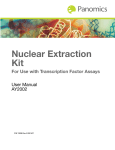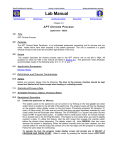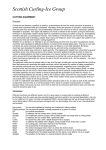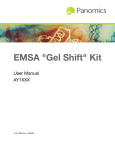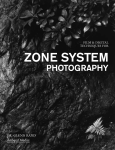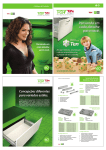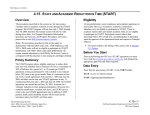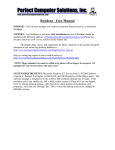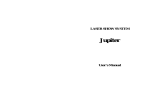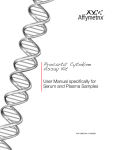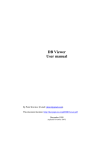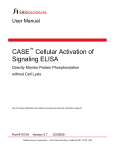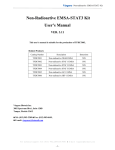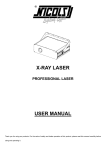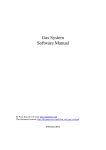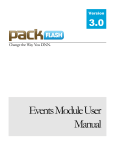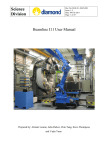Download Transcription Factor ELISA Kit
Transcript
Transcription Factor ELISA Kit User Manual P/N 12490 Rev. C 031808 DRAFT March 18, 2008 5:30 pm ElisaTFTtile.fm Panomics, Inc. Transcription Factor ELISA Kit User Manual Copyright © Copyright 2008, Panomics, Inc. All rights reserved. Trademarks Citing in Publications When describing a procedure for publication using this product, we would appreciate it if you would refer to it as the TF ELISA target specific Kit. For example, if a paper cites the TF ELISA NFκB p50 Kit product and is published in a research journal, the lead author(s) may receive a travel stipend for use at a technology conference or tradeshow by sending a copy of the paper to our technical support group at [email protected] or via fax at (510) 818-2610. Disclaimer Panomics, Inc. reserves the right to change its products and services at any time to incorporate technological developments. This manual is subject to change without notice. Although this manual has been prepared with every precaution to ensure accuracy, Panomics, Inc. assumes no liability for any errors or omissions, nor for any damages resulting from the application or use of this information. DRAFT March 18, 2008 5:30 pm ElisaTFTtile.fm Contents About the User Manual . . . . . . . . . . . . . . . . . . . . . . . . . . . . . . . . . . . . . . . . . . . . . . . . . 5 Who Should Read this Manual. . . . . . . . . . . . . . . . . . . . . . . . . . . . . . . . . . . . . . . 5 What this Manual Covers . . . . . . . . . . . . . . . . . . . . . . . . . . . . . . . . . . . . . . . . . . . 5 Safety Warnings and Precautions . . . . . . . . . . . . . . . . . . . . . . . . . . . . . . . . . . . . 5 For More Information . . . . . . . . . . . . . . . . . . . . . . . . . . . . . . . . . . . . . . . . . . . . . . 5 About the Transcription Factor (TF) ELISA Kit. . . . . . . . . . . . . . . . . . . . . . . . . . . . . . . . 6 Fundamentals of Panomics’ TF ELISA Kits . . . . . . . . . . . . . . . . . . . . . . . . . . . . . 6 Assay Overview . . . . . . . . . . . . . . . . . . . . . . . . . . . . . . . . . . . . . . . . . . . . . . . . . . 6 Panomics’ Transcription Factor ELISA Kit Contents and Storage Conditions . . . . . . . . 7 Kit Contents and Storage . . . . . . . . . . . . . . . . . . . . . . . . . . . . . . . . . . . . . . . . . . . 7 Required Equipment and Materials Not Provided . . . . . . . . . . . . . . . . . . . . . . . . . . . . . 7 Equipment . . . . . . . . . . . . . . . . . . . . . . . . . . . . . . . . . . . . . . . . . . . . . . . . . . . . . . 7 Materials. . . . . . . . . . . . . . . . . . . . . . . . . . . . . . . . . . . . . . . . . . . . . . . . . . . . . . . . 8 Guidelines for Assay Design and Analysis . . . . . . . . . . . . . . . . . . . . . . . . . . . . . . . . . . 9 Preparing Samples. . . . . . . . . . . . . . . . . . . . . . . . . . . . . . . . . . . . . . . . . . . . . . . . 9 General Guidelines . . . . . . . . . . . . . . . . . . . . . . . . . . . . . . . . . . . . . . . . . . . . . . . 9 Analysis of Results . . . . . . . . . . . . . . . . . . . . . . . . . . . . . . . . . . . . . . . . . . . . . . . . 9 Assay Procedure . . . . . . . . . . . . . . . . . . . . . . . . . . . . . . . . . . . . . . . . . . . . . . . . . . . . . . 9 Before You Start . . . . . . . . . . . . . . . . . . . . . . . . . . . . . . . . . . . . . . . . . . . . . . . . . . 9 Forming TF-DNA Complexes . . . . . . . . . . . . . . . . . . . . . . . . . . . . . . . . . . . . . . . . 9 Capturing TF-DNA Complexes . . . . . . . . . . . . . . . . . . . . . . . . . . . . . . . . . . . . . 10 Binding Primary and Secondary Antibodies . . . . . . . . . . . . . . . . . . . . . . . . . . . . 10 Detecting the Signal . . . . . . . . . . . . . . . . . . . . . . . . . . . . . . . . . . . . . . . . . . . . . . 12 Troubleshooting . . . . . . . . . . . . . . . . . . . . . . . . . . . . . . . . . . . . . . . . . . . . . . . . . . . . . . 13 Possible Problems and Recommended Solutions . . . . . . . . . . . . . . . . . . . . . . . 13 Contacting Panomics . . . . . . . . . . . . . . . . . . . . . . . . . . . . . . . . . . . . . . . . . . . . . . . . . . 13 Technical Help . . . . . . . . . . . . . . . . . . . . . . . . . . . . . . . . . . . . . . . . . . . . . . . . . . 13 For Additional Services . . . . . . . . . . . . . . . . . . . . . . . . . . . . . . . . . . . . . . . . . . . 13 Appendix I: Blank Plate Map . . . . . . . . . . . . . . . . . . . . . . . . . . . . . . . . . . . . . . . . . . . . 14 Transcription Factor ELISA Kit User Manual iii About the User Manual About the User Manual Who Should Read Anyone that has purchased a Transcription Factor (TF) ELISA Kit from Panomics to this Manual quantitate the binding activity of a specific TF from nuclear extracts. ] What this Manual This manual provides the following: Covers • Kit contents and storage conditions • Assay procedures • Troubleshooting Safety Warnings CAUTION All chemicals should be considered potentially hazardous. We recommend that and Precautions this product and its components be handled by those trained in laboratory techniques and be used according to the principles of good laboratory practice. CAUTION This kit contains small quantities of sodium azide. Sodium azide reacts with lead and copper plumbing to form explosive metal azides. When disposing, flush drains with a large volume of water to prevent azide accumulation. Observe all state and local regulations for disposal. Note This product is intended for research use only. It is not for diagnosis of disease in humans or animals. For More For information about the products mentioned in this manual, visit our website at Information www.panomics.com. Transcription Factor ELISA Kit User Manual Page 5 About the Transcription Factor (TF) ELISA Kit About the Transcription Factor (TF) ELISA Kit Fundamentals of Panomics' TF ELISA Kits measure the activity of specific transcription factors in Panomics’ TF nuclear extracts.The assay is highly specific and precise, requires a minimum of ELISA Kits 5–10 µg of protein/well, and can be performed in 4 hours. For a complete list of available ELISA Kits, visit www.panomics.com. Assay Overview All assays are performed on the 96-well plate. The illustration uses NFκB p50 as the transcription factor example. TMB 2nd Ab Yellow Color HRP 1st Ab NFkBp50 Biotin Streptavidin Coated Plate Activated NFκB p50 molecules from nuclear extracts bind to an NFκB p50 consensus binding site (NFκB p50 Probe) on a biotinylated oligonucleotide. These oligonucleotides are then immobilized on a streptavidin coated 96-well plate. The NFκB p50, bound to the oligonucleotide, is detected by an antibody directed against NFκB p50. An additional horseradish peroxidase (HRP)-conjugated secondary antibody reacts with the TMB substrate to provide a sensitive colorimetric readout which is quantified by spectrophotometry. TMB or tetramethylbenzidine is a chromogen that yields a blue color when oxidized with hydrogen peroxide (catalyzed by HRP) with major absorbances at 370 nm and 652 nm. The color then changes to yellow with the addition of a stop solution (phosphoric acid) with maximum absorbance at 450 nm Page 6 Transcription Factor ELISA Kit User Manual Panomics’ Transcription Factor ELISA Kit Contents and Storage Conditions Panomics’ Transcription Factor ELISA Kit Contents and Storage Conditions Kit Contents and The TF ELISA Kit contains the following components. Refer to the product insert for Storage quantities and details of components supplied. If stored properly, reagents have a shelf-life of 6 months. IMPORTANT Avoid repeated freeze-thaw cycles of nuclear extract. TF ELISA Kit components: Component Description Storage Location Positive Control Nuclear extract or recombinant protein for positive assay control of specific target. –80 °C Box 1 TF Specific Probe Biotin-labeled double stranded oligonucleotide with consensus sequences for specific TF. –20 °C Box 1 TF Specific Cold Probe Non-labeled double stranded oligonucleotide corresponding with probe. Cold probe is optional as a negative control to measure competition of the labeled probe. –20 °C Box 1 Binding Buffer Aqueous buffered solution for TF binding. –20 °C Box 1 Antibody Dilution Buffer Aqueous buffered solution for diluting antibody. –20 °C Box 1 Nuclear Extract Dilution Buffer Aqueous buffered solution for diluting nuclear extract. –20 °C Box 1 Primary Antibody 200x antibody recognizing the specific TF protein. 4 °C Box 2 Secondary Antibody 200x IgG HRP conjugated antibody, specific to the IgG of the primary antibody. 4 °C Box 2 10x Wash Buffer Aqueous buffered solution for washing off non-specific binding. 4 °C Box 2 Substrate Solution Chromogenic reagents for HRP. 4 °C Box 2 Stop Solution Aqueous solution for stopping the chromogenic reaction. 4 °C Box 2 Plate Seal Clear plastic seals for sealing plates during the assay. 15–30 °C Box 2 Assay Plate (12 strips) 96-well clear streptavidin coated plate with 12 strips, and white plastic holder. 15–30 °C Box 2 Sample Plate 96-well v-bottom plate. 15–30 °C Box 2 Required Equipment and Materials Not Provided Equipment Item Source Microplate Spectrophotometer with 450 nm filter TECAN Phenix GENios model F129015, or equivalent Rocking platform VWR (P/N 40000-300) Plate washer (optional) Bio-Rad ImmunoWash model 1575, or equivalent Transcription Factor ELISA Kit User Manual Page 7 Required Equipment and Materials Not Provided Materials Page 8 Item Source Reagent Reservoirs, 25 mL and 100 mL capacities Diversified Biotech (P/N RESE-3000, RESE-1000) Nuclear Extraction Kit Panomics (P/N AY2002) Nuclease-free, sterile water Major laboratory supplier Transcription Factor ELISA Kit User Manual Guidelines for Assay Design and Analysis Guidelines for Assay Design and Analysis Preparing Samples Protein concentration of sample inputs should be at least 0.5–2 µg/µL. General Guidelines • Read this user manual and all product inserts before performing the assay • Store all reagents at the recommended temperatures • Use Panomics’ Nuclear Extraction Kit for best results Note The Assay Plate contains 12 strips which you can use separately Analysis of Results The positive control should generate an absorbance above 0.5. The blank wells should generate an absorbance below 0.2. These values were obtained using a TECAN/Phenix GENios at 450 nm, other instruments may give different results. The ratio of the provided positive control to the blank well should be 2.5 or higher. The ratio of positive control to the competitive control (cold probe) should be 2.0 or higher. For best results, follow the instructions that accompany the spectrophotometer. Assays CVs (%CV = [std dev/mean] x 100) are typically less than 15% for technical replicates. Assay Procedure Before You Start • Thaw Positive Control and sample extracts on ice. • Thaw TF Specific Probe and TF-Specific Cold Probe on ice. • Prepare 1X Wash Buffer by diluting 60 mL of 10X Wash Buffer into 540 mL of nuclease-free, sterile water. Note 1X Wash Buffer is good for 6 months at 4 °C. Forming TF-DNA To form TF-DNA complexes: Complexes Step Action 1 Using the blank plate map in Appendix I, prepare an experimental plate map for the Sample Plate designating which wells are samples, positive controls, blank wells, and competition controls. 2 Prepare a Binding Buffer Master Mix. Each well of the Sample Plate requires 40 µL of Binding Buffer Master Mix. Combine the following reagents (multiply the volumes by the number of wells you are running): • 10 µL Binding Buffer • 2.5 µL TF-Specific Probe • 27.5 µL nuclease-free water 40 µL Total per well x Number of wells Transcription Factor ELISA Kit User Manual Page 9 Assay Procedure To form TF-DNA complexes: (continued) Step 3 Action If a negative control is desired, cold probe can be used to confirm competitive binding of the labeled probe. Combine the following reagents as such: • 10 µL Binding Buffer • 2.5 µL TF-Specific Probe • 10 µL TF-Specific Cold Probe • 17.5 µL nuclease-free water 40 µL Total per well 4 Dispense 40 µL of Binding Buffer Master Mix to each well of the Sample Plate. If running a negative control, dispense 40 µL from the mixture made in step 3. 5 Add 10 µL of the Positive Control (provided in the kit) to the positive control and negative control wells. 6 Prepare samples and add them to the Sample Plate: a. Dilute nuclear extracts to 0.5–2.0 µg/µL using Nuclear Extract Dilution Buffer. b. Add 10 µL of the diluted extracts to the appropriate wells of the Sample Plate. 7 Prepare blank wells by adding 10 µL of Nuclear Extract Dilution Buffer to the appropriate Sample Plate wells. 8 Seal the Sample Plate using a Plate Seal and incubate at room temperature for 30 minutes rocking the plate gently at 150 rpm. Capturing TF-DNA To capture TF-DNA complexes: Complexes Step 1 Action Wash the Assay Plate: a. Add 200 µL/well of 1X Wash Buffer. b. Invert the Assay Plate over an appropriate receptacle and expel the contents forcibly. c. Dry the surface by tapping the inverted plate firmly on a clean paper towel. d. Repeat twice for a total of 3 washes. IMPORTANT To avoid cross contamination, do not touch pipet tips to the Assay Plate or liquid within the Assay Plate. Note This wash step and subsequent wash steps can be performed using a plate washer if desired. 2 Transfer 45 µL from each well of the Sample Plate to each well of the Assay Plate. 3 Seal the Assay Plate with a Plate Seal and incubate at room temperature for 1 hour rocking the plate gently at 150 rpm. Binding Primary To bind primary and secondary antibodies: and Secondary Step Action Antibodies 1 Page 10 Invert the Assay Plate over an appropriate receptacle and expel the contents forcibly. Transcription Factor ELISA Kit User Manual Assay Procedure To bind primary and secondary antibodies: (continued) Step 2 Action Wash the Assay Plate: a. Add 200 µL/well of 1X Wash Buffer. b. Invert the Assay Plate over an appropriate receptacle and expel the contents forcibly. c. Remove excess wash buffer by inverting the plate and tapping firmly on a clean paper towel. d. Repeat twice for a total of 3 washes. IMPORTANT To avoid cross contamination, do not touch pipet tips to the Assay Plate or liquid within the Assay Plate. 3 Prepare fresh Primary Antibody by diluting it 1:200 using Antibody Dilution Buffer, then invert to mix. For example, for one 96-well plate, mix 50 µL of Primary Antibody with 9950 µL of Antibody Dilution Buffer. 4 Add 100 µL/well of the diluted Primary Antibody to the Assay Plate. 5 Seal the Assay Plate with a Plate Seal and incubate at room temperature for 1 hour rocking the plate gently at 150 rpm. 6 Invert the Assay Plate over an appropriate receptacle and expel the contents forcibly. 7 Wash the Assay Plate: a. Add 200 µL/well of 1X Wash Buffer. b. Invert the Assay Plate over an appropriate receptacle and expel the contents forcibly. c. Remove excess wash buffer by inverting the plate and tapping firmly on a clean paper towel. d. Repeat twice for a total of 3 washes. IMPORTANT To avoid cross contamination, do not touch pipet tips to the Assay Plate or liquid within the Assay Plate. 8 Prepare fresh Secondary Antibody by diluting it 1:200 using Antibody Dilution Buffer, then invert to mix. For example, for one 96-well plate, mix 50 µL of Secondary Antibody with 9950 µL of Antibody Dilution Buffer. 9 Add 100 µL/well of the diluted Secondary Antibody to the Assay Plate. 10 Seal the Assay Plate with a Plate Seal and incubate at room temperature for 1 hour rocking the plate gently at 150 rpm. Note At this point, remove the Substrate Solution and Stop Solution from 4 °C and equilibrate to room temperature. 11 Invert the Assay Plate over an appropriate receptacle and expel the contents forcibly. Transcription Factor ELISA Kit User Manual Page 11 Assay Procedure To bind primary and secondary antibodies: (continued) Step 12 Action Wash the Assay Plate: a. Add 200 µL/well of 1X Wash Buffer. b. Invert the Assay Plate over an appropriate receptacle and expel the contents forcibly. c. Remove excess wash buffer by inverting the plate and tapping firmly on a clean paper towel. d. Repeat twice for a total of 3 washes. IMPORTANT To avoid cross contamination, do not touch pipet tips to the Assay Plate or liquid within the Assay Plate. Detecting the To detect the signal: Signal Step Page 12 Action 1 Add 100 µL/well of Substrate Solution to the Assay Plate. 2 Incubate the Assay Plate at room temperature for 5–15 minutes in the dark, until there is a medium blue color developed in the wells. Do not overdevelop as this will increase the background signal. 3 Add 100 µL/well of Stop Solution to the Assay Plate. The color should change from blue to yellow. 4 Read the plate in the spectrophotometer at 450nm within 5 minutes of adding the Stop Solution. Transcription Factor ELISA Kit User Manual Troubleshooting Troubleshooting Possible Problems and Recommended Solutions Observation Possible Cause Recommended Action Weak or no signal Reagents not added in correct order Follow instructions in the user manual for performing the assay. Presence of assay inhibitors For example, sodium azide inhibits HRP reaction. We recommend only using the buffers provided in the kit. Incorrect spectrophotometer settings Check to make sure the wavelength is 450 nm. Insufficient protein Increase the amount of protein in the nuclear extract. We recommend preparing nuclear extracts with Panomics’ Nuclear Extraction Kit (P/N AY2002). Target protein not activated (induced) Review induction procedures. You may need to change cell lines, inducer, or induction conditions. Samples overdeveloped Shorten the development time. Incorrect quantities of antibody or wash buffer was used Check to make sure dilutions were performed correctly, all wells are filled with wash buffer during wash steps, and residual wash buffer removed by inverting plate on a paper towel. High background Contacting Panomics Technical Help For technical questions, contact our technical support group by telephone at 1-877-726-6642 option 3 or by email at [email protected] (US and Canada). For technical support in Europe, email [email protected]. You can also visit our website www.panomics.com for an updated list of FAQs and product support literature. For Additional For information about Panomics products or for ordering information, contact your Services Regional Sales Manager, or visit our website at www.panomics.com. Transcription Factor ELISA Kit User Manual Page 13 Appendix I: Blank Plate Map Appendix I: Blank Plate Map ! " # $ % & ' ( Page 14 Transcription Factor ELISA Kit User Manual














